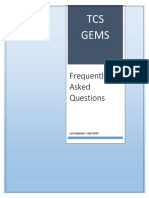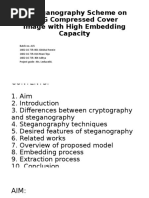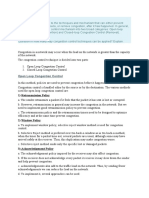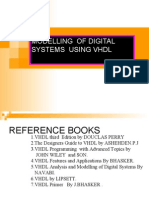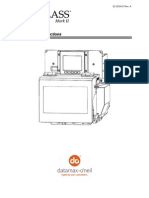33%(3)33% found this document useful (3 votes)
316 viewsSolve The Following Questions With The Relevant Answer.: Case Study
The document contains two case studies:
1) Developing the transformation for finding the reflection point of a line. The reflection point formula is derived in matrix form.
2) Explaining image segmentation using segments. Segments allow subdivision, scaling, rotation of images. Functions like segment creation, closing, deleting and renaming are described.
Uploaded by
SaurabhChaudharyCopyright
© © All Rights Reserved
Available Formats
Download as PDF, TXT or read online on Scribd
33%(3)33% found this document useful (3 votes)
316 viewsSolve The Following Questions With The Relevant Answer.: Case Study
The document contains two case studies:
1) Developing the transformation for finding the reflection point of a line. The reflection point formula is derived in matrix form.
2) Explaining image segmentation using segments. Segments allow subdivision, scaling, rotation of images. Functions like segment creation, closing, deleting and renaming are described.
Uploaded by
SaurabhChaudharyCopyright
© © All Rights Reserved
Available Formats
Download as PDF, TXT or read online on Scribd
You are on page 1/ 2
Case Study
Solve the following questions with the relevant answer.
Q1. Develop the transformation for finding the reflection point w.r.t. the line ax+by+c=0
For ax+by+c=0 the vector direction (a,b) is perp to the line
The reflection of a given pt (X,Y) lies along the line (x,y) = (X,Y)+λ(a,b)
This intersects ax+by+c=0 when a(X+λa)+b(Y+λb)+c=0 → λ = −(aX+bY+c)/(a²+b²)
So reflection is at pt 2λ i.e. (X’,Y’) = (X,Y)+2λ(a,b) = (X,Y) – 2(aX+bY+c)(a,b)/(a²+b²)
X’ = (1−2a²/(a²+b²))X – (2ab/(a²+b²))Y – 2ac/(a²+b²)
Y’ = (−2ab/(a²+b²))X + (1−2b²/(a²+b²))Y – 2bc/(a²+b²)
In matrix form this is <X’,Y’> = (I−2nnᵀ/(nᵀn))<X,Y> − 2cn/(nᵀn) where n=<a,b>
Explain with examples the operation of segments.
To view an entire image or a part of an image with various attributes, we need to
organize image information in a particular manner since the existing structure of display
file does not satisfy our requirements of viewing an image. To achieve this display, the
file is divided into Segments. Each segment corresponds to a component and is
associated with a set of attributes and image transformation parameters like scaling,
rotation. Presence of Segment allows :
• Subdivision of picture.
• Visualization of a particular part of the picture.
• Scaling, rotation and translation of picture.
Functions for Segmenting the display :
Segment Creation: Segment must be created or opened when no other segment is
open since two segments can’t be opened at the same time because it’s difficult to
assign drawing instruction to a particular segment. The segment created must be given
a name to identify it which must be a valid one and there should be no segment with the
same name. After this, we initialize items in segment table under our segment name and
the first instruction of this segment is allocated at next free storage in display file and
attributes of segments are initialized to default.
Closing a Segment: After completing entry of all display file instructions, the segment
needs to be closed for which it has to be renamed, which is done by changing the name
of a currently open segment as 0. Now the segment with name 0 is open i.e. unnamed
segment is open and if two unnamed segments are present in display file one needs to
be deleted.
Deleting a Segment: To delete a particular segment from display file, we must just
delete that one segment without destroying or reforming the entire display and recover
space occupied by this segment. Use this space for some other segment. The method to
achieve this depends upon the data structure used to represent a display file. In the
case of arrays, the gap left by the deleted segment is filled by shifting up all the
segments following it.
Renaming a Segment: This is done to achieve Double Buffering i.e. the idea of storing
two images, one to show and other to create, alter and for animation.
Advantages of using segmented display :
• Segmentation allows to organize display files in sub-picture structure.
• It allows to apply different set of attributes to different portions of image.
• It makes it easier to the picture by changing/replacing segments.
• It allows application of transformation on selective portions of image.
The pyramid is defined by the coordinates A(0,0,0), B(1,0,0),C(0,1,0) and D(0,0,1) is
rotated 90 degrees about the line L that has direction vector V= i +j +k and passing
through the origin. Find the co-ordinates of rotated figure.
You might also like
- Annual Appraisal 2010-2011 Evaluation For Prashant Prakash14% (7)Annual Appraisal 2010-2011 Evaluation For Prashant Prakash95 pages
- Use These Mcqs As A Reference Purpose. All The BestNo ratings yetUse These Mcqs As A Reference Purpose. All The Best197 pages
- Ramachandra Reddy D (521511) Kaiser MSRPU CARS Offshore (2181461) Final Anniversary (2011-2012) DeveloperNo ratings yetRamachandra Reddy D (521511) Kaiser MSRPU CARS Offshore (2181461) Final Anniversary (2011-2012) Developer8 pages
- Health and Safety at TCS - Ireland - Quiz - 13 - 17 - 43 (GMT +0530)0% (4)Health and Safety at TCS - Ireland - Quiz - 13 - 17 - 43 (GMT +0530)1 page
- Image Classification Handson-Image - TestNo ratings yetImage Classification Handson-Image - Test5 pages
- A Steganography Scheme On JPEG Compressed Cover Image With High Embedding CapacityNo ratings yetA Steganography Scheme On JPEG Compressed Cover Image With High Embedding Capacity23 pages
- SPEED Goals and Attributes PDF InformationNo ratings yetSPEED Goals and Attributes PDF Information1 page
- 1 Elements of User Experience Final AssessmentNo ratings yet1 Elements of User Experience Final Assessment8 pages
- AngularJS 1.x Routers and Custom Directives Q&ANo ratings yetAngularJS 1.x Routers and Custom Directives Q&A4 pages
- TCS Questions, Answers With ExplanationsNo ratings yetTCS Questions, Answers With Explanations9 pages
- Hardware For Multimedia: (Connections) 30-Aug-2016No ratings yetHardware For Multimedia: (Connections) 30-Aug-201614 pages
- Hardware in Multimedia (IP-OP Devices and Softwares)No ratings yetHardware in Multimedia (IP-OP Devices and Softwares)12 pages
- Computer Communication Network (OMC 403) - Assignment B0% (6)Computer Communication Network (OMC 403) - Assignment B3 pages
- Management Information System (OMC 401) - Assignment A100% (1)Management Information System (OMC 401) - Assignment A4 pages
- Wing Pendidikan 200/elektronika Skadron Pendidikan 203No ratings yetWing Pendidikan 200/elektronika Skadron Pendidikan 20313 pages
- How To Plan PCB Projects From Design To Examples100% (1)How To Plan PCB Projects From Design To Examples16 pages
- Mini Conveyor Belt: - Using Geneva MechanismNo ratings yetMini Conveyor Belt: - Using Geneva Mechanism22 pages
- Automated Welding Manipulators Available Manipulator SizesNo ratings yetAutomated Welding Manipulators Available Manipulator Sizes4 pages
- Five Project Management Performance Metrics Key To Successful Project ExecutionNo ratings yetFive Project Management Performance Metrics Key To Successful Project Execution7 pages
- Traveler 9.0.1 High Availability Setup and Best Practice: Speaker: Wang Rui Si IBM ICS Software EngineerNo ratings yetTraveler 9.0.1 High Availability Setup and Best Practice: Speaker: Wang Rui Si IBM ICS Software Engineer43 pages
- Deep Learning in C# - Understanding Neural Network Architecture - CodeProjectNo ratings yetDeep Learning in C# - Understanding Neural Network Architecture - CodeProject4 pages
- Notes On Philosophy and The Scientific Image of ManNo ratings yetNotes On Philosophy and The Scientific Image of Man6 pages
- Twist, Writhe, and Geometry A Loop Containing Equally Spaced Coplanar BendsNo ratings yetTwist, Writhe, and Geometry A Loop Containing Equally Spaced Coplanar Bends16 pages
- Comparison of Conventional and Bio-Treated Methods As Dust SuppressantsNo ratings yetComparison of Conventional and Bio-Treated Methods As Dust Suppressants10 pages
- Cutter Option: Installation InstructionsNo ratings yetCutter Option: Installation Instructions14 pages







